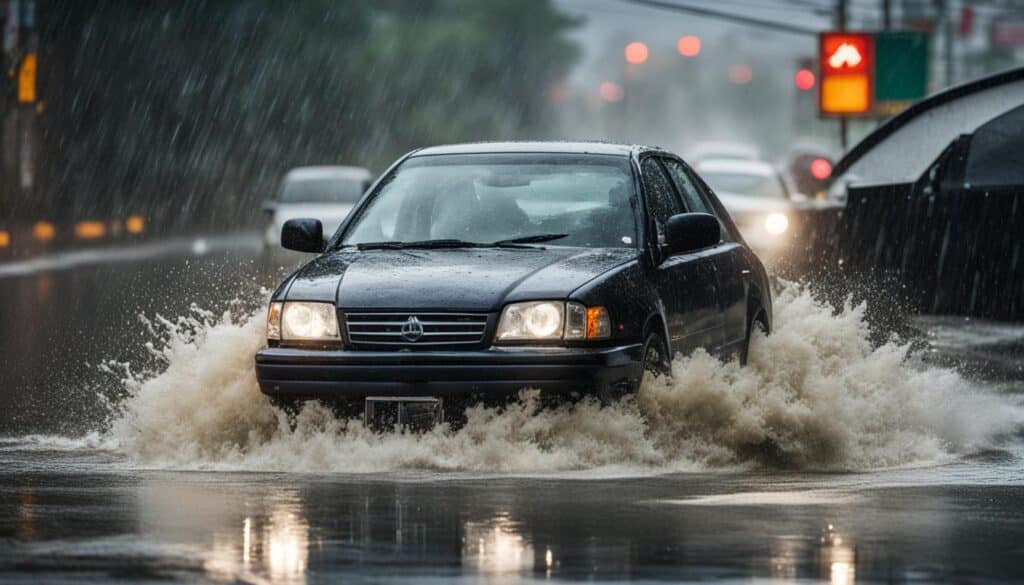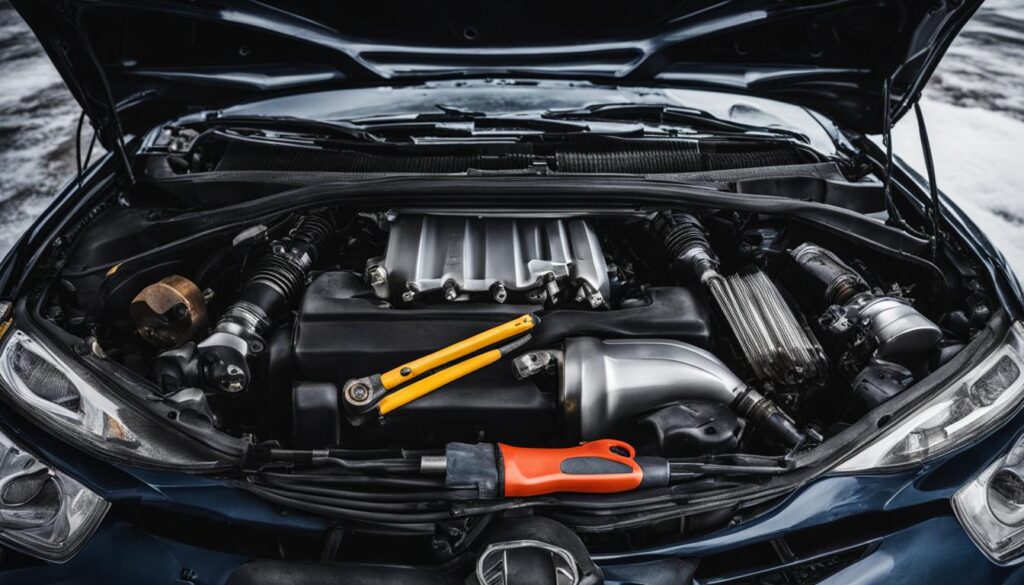As a driver, understanding how weather conditions affect your car’s performance is crucial for optimizing your driving experience and ensuring safety on the road. This is especially important in New Zealand, where weather conditions can vary significantly from region to region and season to season.
From extreme heat to icy conditions, different weather conditions can impact your car’s performance and safety in various ways. In this article, I will explore the relationship between NZ weather and car performance, covering the effects of different weather conditions and providing valuable tips to help you adapt and optimize your driving experience.
Key Takeaways:
- Weather conditions in New Zealand can significantly impact car performance and driving safety.
- Understanding how different weather conditions affect your car can help you optimize your driving experience.
- Adapting your car’s performance to different climates is essential for maintaining optimal performance.
- Regular car maintenance is crucial for ensuring optimal performance regardless of weather conditions.
- Additional safety precautions are necessary when driving in challenging weather conditions.
How Weather Affects Car Performance
Weather conditions can have a significant impact on your car’s performance. As a driver, it is crucial to understand how different weather conditions affect your vehicle to optimize its performance and ensure safe driving. In this section, I will explore the ways in which weather conditions can influence your car’s performance and provide valuable performance tips for driving in different weather conditions.
Effects of Weather on Car Performance
Extreme weather conditions such as hot or cold temperatures, heavy rain, or snow can affect your car’s engine, tires, and overall performance. In hot weather, the engine and transmission can overheat, reducing fuel efficiency and causing potential damage. Cold weather can make it harder for your engine to start and cause your tires to lose traction, resulting in decreased handling and control. Additionally, rainy weather can cause roads to become slick, making it harder to stop or maneuver your vehicle safely.
Performance Tips for Driving in Different Weather Conditions
Regardless of the weather conditions, there are steps you can take to optimize your car’s performance and ensure safe driving. Below are some helpful tips:
- Hot Weather: To prevent overheating, make sure your car’s cooling system is working correctly, and consider using sunshades or parking in the shade to keep your car cool. It is also essential to check your tire pressure regularly and ensure your tires are in good condition.
- Cold Weather: Before driving, allow your engine to warm up, and make sure your battery is fully charged. Ensure your tires have adequate tread and are correctly inflated to prevent losing traction on cold, slick roads.
- Wet Weather: It is crucial to slow down and increase your following distance in rainy conditions. Make sure your windshield wipers are working correctly and use headlights to increase visibility. Additionally, avoid driving through puddles or standing water, as it can lead to hydroplaning.
- Snowy/Icy Weather: Use winter tires if possible and make sure your wiper fluid is winter-rated. Slow down, increase your following distance, and avoid sudden acceleration or braking. Use low gears for better traction on hills and avoid using cruise control in snowy or icy conditions.
By following these tips and taking appropriate safety precautions, you can optimize your vehicle’s performance and ensure safe driving in any weather condition.

NZ Weather Conditions and Their Impact on Car Performance
When it comes to optimizing car performance in NZ weather, understanding the potential impacts of weather conditions is essential. Not only can weather conditions affect driving safety, but they can also have a significant impact on how your car performs on the road.
As someone who frequently drives in New Zealand, it’s important to know what weather conditions you may encounter and how to adapt your driving to optimize your vehicle’s performance. Below are some tips to help you navigate different weather conditions safely and maintain optimal car performance:
- Check your tire pressure regularly: Tire pressure can fluctuate in changing weather conditions, so it’s important to monitor it regularly. Properly inflated tires can help improve handling and fuel efficiency, ensuring optimal car performance in any weather.
- Use appropriate tires: In snowy or icy conditions, it’s recommended to use winter tires to maintain traction and control. In wet conditions, consider using tires with a tread pattern designed to manage water on the road.
- Brake and accelerate gently: Abrupt braking and acceleration can cause your car to lose traction in wet or icy conditions, so it’s important to brake and accelerate gently and steadily.
- Adjust your driving to the weather: In rainy or windy conditions, be sure to slow down and give yourself more time to react to potential hazards on the road. In snowy or icy conditions, adjust your driving speed and maintain a safe distance from other vehicles.
- Perform regular car maintenance: Regular car maintenance such as oil changes, fluid checks, and filter replacements can help optimize car performance in any weather condition. Be sure to follow your car’s recommended maintenance schedule.
By following these tips, you can optimize your car’s performance in any weather condition and maintain safe driving practices. Remember, driving in changing weather conditions requires additional attention and care, so always be vigilant and adapt accordingly.
Table: Common NZ Weather Conditions and Their Impact on Car Performance
| Weather Condition | Impact on Car Performance |
|---|---|
| Heavy Rain | Reduced visibility, decreased traction, increased risk of hydroplaning |
| Windy Conditions | Difficulty maintaining control, decreased fuel efficiency |
| Snowy or Icy Conditions | Reduced traction, difficulty maintaining control, decreased fuel efficiency |
| Extreme Heat | Increased risk of overheating, decreased fuel efficiency |
| Extreme Cold | Difficulty starting the car, decreased battery life, decreased fuel efficiency |

Adapting Car Performance to Different Climates
As we’ve discussed, weather conditions can significantly impact your car’s performance. To maintain optimal performance in changing weather, it’s essential to adapt your vehicle accordingly.
Firstly, it’s important to adjust your tire pressure. In colder weather, tires lose pressure, reducing fuel efficiency and traction. Conversely, in hot weather, tires expand, increasing the risk of a blowout. Regularly checking and adjusting tire pressure will help ensure your vehicle performs optimally in any climate.
Secondly, ensure your car’s fluids are prepared for the climate. In colder weather, replace motor oil with a winter-grade oil to ensure your engine runs smoothly. Additionally, use a thinner transmission fluid and a high-quality coolant to maximize performance. In hotter weather, use a thicker motor oil to prevent overheating and ensure proper lubrication.
Thirdly, consider installing all-weather tires. These are designed to handle a variety of weather conditions, ensuring optimal performance and safety year-round.
Finally, regularly maintain your car’s components to ensure they are functioning correctly. Check the battery, brakes, and air filter regularly to ensure they are performing optimally, regardless of the weather.
Adapting to Different Climates – A Quick Guide
| Climate | Adaptations |
|---|---|
| Cold | Check and adjust tire pressure, use winter-grade oil, thin transmission fluid, high-quality coolant, and maintain battery, brakes, and air filter. |
| Hot | Check and adjust tire pressure, use thicker motor oil, and maintain battery, brakes, and air filter. |
| Wet | Check and adjust tire pressure, maintain windshield wipers, and ensure all-weather tires. |
| Snowy or Icy | Check and adjust tire pressure, use winter-grade oil, maintain battery, brakes, and air filter, and consider using snow tires or chains. |

By adapting your car’s performance to different climates, you can ensure optimal performance and driving safety year-round. Regular maintenance and adjustments are key to achieving maximum performance in any weather condition.
Enhancing Performance in Hot Weather
In hot weather conditions, car performance can be negatively affected. It’s important to take steps to maintain optimal performance and ensure safety on the road. Here are some tips for driving in hot weather:
- Stay cool: Keep your car cool by parking in a shaded area or using a sunshade. Turn on the air conditioning system before driving.
- Check your tires: Hot weather can cause tires to overinflate. Check your tire pressure regularly to avoid any issues.
- Keep your engine cool: Make sure your car’s coolant level is adequate and the radiator is functioning correctly. Overheating can cause significant damage to your vehicle.
- Drive smoothly: In hot weather, it’s essential to drive smoothly and avoid sudden stops or aggressive maneuvers that can put extra strain on your car.
By following these tips, you can enhance your car’s performance and ensure safety while driving in hot weather conditions.

Overcoming Challenges in Cold Weather
Driving in cold weather conditions presents a range of unique challenges for vehicles. In this section, I will discuss some of the ways that cold weather can impact car performance and provide tips for driving safely in these conditions.
The Impact of Cold Weather on Car Performance
Cold weather can impact various aspects of car performance, including engine function, tire pressure, and battery life. As temperatures drop, engines can become harder to start and run less efficiently due to increased viscosity in oil and other fluids. Low temperatures can also cause tire pressure to decrease, leading to decreased traction and handling. Additionally, cold weather can reduce battery life, making it more difficult for engines to start.
It is important to be aware of these impacts and take steps to mitigate them when driving in cold weather conditions.
Tips for Driving in Cold Weather Conditions
Here are some essential tips for driving safely and optimizing car performance in cold weather:
- Allow extra time for your car’s engine to warm up before driving.
- Check your tire pressure regularly and inflate as needed.
- Consider using winter tires for increased traction and handling in cold conditions.
- Use your car’s defrost setting to keep your windshield and windows clear and maximize visibility.
- Use a battery blanket or trickle charger to maintain battery life in cold weather.
- Keep your gas tank at least half-full to prevent fuel lines from freezing.
By following these tips, you can maintain optimal car performance and ensure safe driving in cold weather conditions.

“In cold weather, it is important to take extra precautions to ensure your safety on the road. By understanding the impact of cold weather on car performance and following the tips provided, you can optimize your driving experience and minimize risks while driving in cold conditions.”
The Role of Rain and Wet Conditions
When driving in wet weather, it’s essential to understand how it can affect your car’s performance. Wet conditions can significantly decrease traction between the tires and the road, which can make driving more challenging and dangerous. According to recent research, wet roads can increase the stopping distance of a car by up to four times compared to dry roads. This increased stopping distance can make it more challenging to avoid accidents, especially at high speeds.
Tips for Driving Safely in Rainy Weather
To ensure safe driving in rainy conditions, it’s essential to adjust your driving habits and follow a few key tips:
- Reduce your speed: Wet roads can decrease your car’s traction and increase your stopping distance, so it’s essential to drive slower than usual. Reducing your speed can give you more time to react to any potential hazards.
- Turn on your lights: Visibility can also be challenging in rainy weather, so it’s important to turn on your headlights to help other drivers see you.
- Keep a safe distance: It’s important to maintain a safe distance from other cars when driving in wet conditions. This distance can give you more time to react to sudden stops or hazards.
- Brake carefully: When braking in wet weather, it’s essential to do so carefully. It’s best to brake slowly and gently to avoid skidding or losing control of your car.
By following these tips, you can maintain driving safety in wet conditions and minimize the risk of accidents.
Optimizing Car Performance in Wet Conditions
Driving safely in rainy weather also means optimizing your car’s performance. Here are a few tips to ensure your car is ready for wet conditions:
- Check your tires: Tires are your car’s primary contact with the road, so it’s essential to make sure they have proper tread depth and air pressure. In wet conditions, it’s also crucial to consider switching to specialized wet-weather tires.
- Replace windshield wipers: Good visibility is essential in rainy weather, so it’s important to have effective windshield wipers. Replace them regularly to ensure they are in good working condition.
- Check your brakes: Your brakes are critical for safe driving in any condition, but they are especially important in wet weather. Have your brakes checked regularly to ensure they are in good working order.
By optimizing your car’s performance for wet conditions, you can ensure safe and reliable driving even in challenging weather.

Navigating Snow and Ice
Driving in snowy and icy conditions can be extremely challenging and requires additional safety precautions. These weather conditions can significantly affect car performance, including traction and control, making it difficult to navigate and maintain safe driving. To ensure that you are prepared for driving in snowy and icy weather, it is essential to understand how these conditions impact car performance and adhere to the following tips.
How snow and ice affect car performance
Snow and ice can create hazardous driving conditions that reduce a car’s traction and stability. When driving in snow and ice, it is essential to be cautious and slow down as it takes longer to stop on slippery surfaces.
Icy weather can also impact tires’ grip on the road, reducing traction and making it harder to control your vehicle. Black ice, in particular, is difficult to spot and can cause a vehicle to slide out of control, significantly impacting driving safety.
To better adapt to driving in snowy and icy conditions, it is crucial to adjust your driving techniques.
Tips for driving in snowy and icy weather
- Slow down. It takes longer to stop on icy roads, so make sure to reduce your speed and give yourself plenty of time to react.
- Increase your following distance. Leave at least 6 seconds of following distance between you and the car in front of you.
- Use winter tires. Winter tires provide better traction and control in snowy and icy conditions.
- Avoid sudden movements. Quick turns or sudden braking can cause your vehicle to lose control.
- Use your headlights. Make sure your headlights are turned on, even during the day, to increase visibility.
- Be cautious on bridges and overpasses. These areas are more likely to freeze and become icy, so reduce your speed and approach them with caution.
The importance of preparing your car for snowy and icy weather
In addition to adjusting your driving techniques, it is also essential to prepare your car for snowy and icy weather. Winter maintenance is crucial to ensure that your car can handle the extreme weather conditions commonly experienced during the winter months.
Some steps you can take to prepare your car include:
- Checking your antifreeze levels and ensuring that your car’s radiator is functioning correctly.
- Replacing your windshield wipers with winter blades that are designed to handle snow and ice.
- Keeping your gas tank at least half full to prevent fuel line freeze.
- Checking your tire pressure and ensuring that your tires have adequate tread for handling snowy and icy conditions.
- Carrying emergency supplies such as blankets, food, and water, in case of a breakdown or accident.
By taking these steps, you can help ensure that your car is ready for snowy and icy weather, reducing the risk of accidents and improving driving safety.

Maintaining Fuel Efficiency in Changing Climates
Weather conditions can directly affect fuel efficiency. Extreme temperatures, whether hot or cold, can impact fuel consumption and cause additional strain on your vehicle’s engine. To optimize fuel efficiency in changing climates, it’s essential to take proactive steps in car maintenance.
The following are some helpful tips to maintain fuel efficiency in changing weather conditions:
- Schedule regular car maintenance. Regular oil changes, tire rotations, and engine tune-ups are crucial for optimal fuel efficiency and overall vehicle performance
- Check tire pressure regularly. Under-inflated tires can increase fuel consumption by up to 3%
- Use the recommended grade of motor oil. Using the wrong grade of motor oil can cause your engine to work harder and reduce fuel efficiency
- Remove unnecessary weight from your vehicle. Extra weight, such as heavy luggage or sports equipment, can decrease fuel efficiency
- Avoid idling for extended periods. Idling for more than one minute wastes fuel and can be harmful to the environment
By taking these steps, you can maintain optimal fuel efficiency in changing climates and reduce your carbon footprint.
For more information on car maintenance and optimizing fuel efficiency, consult your vehicle’s user manual or speak with a qualified mechanic.

The Importance of Regular Car Maintenance
As a responsible car owner, keeping up with regular maintenance is critical to ensuring optimal car performance and lifespan. Regular maintenance can also save you money and stress by preventing breakdowns and expensive repairs down the line. Here are some tips for maintaining your car:
- Regular check-ups: Schedule regular check-ups with a certified mechanic to keep your car in top shape. This should include oil changes, tire rotations, and brake inspections.
- Fluids: Check all fluid levels regularly, including oil, brake fluid, power steering fluid, and transmission fluid. Top off or replace fluids as needed.
- Tires: Check tire pressure and condition regularly, and rotate your tires according to the manufacturer’s recommendations. This will ensure even wear and extend their lifespan.
- Filters: Replace air filters and cabin filters regularly to ensure proper airflow and prevent damage to your engine.
- Battery: Check your car battery regularly and replace it if it’s more than three years old.
Maintaining your car not only helps to optimize performance but also increases safety on the road. Don’t wait until something goes wrong to start taking care of your vehicle. Regular maintenance is key to ensuring that your car runs smoothly and safely for years to come.

“Regular maintenance is key to keeping your car running smoothly and preventing expensive repairs.”
Safety Precautions and Driving Tips for Challenging Weather
Driving in challenging weather conditions requires extra precautions to ensure safety on the road. Here are some essential tips to help you navigate difficult weather conditions:
- Slow down: Reduce your speed and maintain a safe following distance. This gives you more time to react to any unexpected situations while driving.
- Use your headlights: Turn on your headlights in rainy, foggy, or snowy conditions, and make sure they are clean and working correctly.
- Brake and steer gently: Brake smoothly and steer gently to avoid skidding or losing control of your vehicle.
- Be alert: Stay focused and alert while driving in challenging weather conditions. Keep an eye out for any hazards on the road.
- Prepare your vehicle: Make sure your vehicle is equipped with appropriate tires and other necessary equipment to handle the weather conditions.
By following these tips, you can minimize risks on the road and ensure driving safety in challenging weather conditions.

Conclusion
As a driver in New Zealand, it is essential to understand how weather conditions can impact your car’s performance and your driving safety. By following the tips and strategies outlined in this article, you can optimize your vehicle’s performance and ensure safe driving in any climate.
Remember, different weather conditions require different driving approaches. Whether you’re driving in hot weather, navigating snow and ice, or dealing with rainy conditions, it is crucial to adjust your driving based on the current weather conditions.
Regular car maintenance is also vital for optimal performance, especially in changing weather conditions. Be sure to stay on top of regular maintenance, including oil changes, tire rotations, and fluid checks, to ensure your car is running at its best year-round.
Stay Safe on the Road
When driving in challenging weather conditions, always prioritize safety. Slow down, leave extra space between your vehicle and others on the road, and stay alert for any hazards. By taking these precautions and following the driving tips provided, you can reduce your risk of accidents and stay safe on the road.
Thank you for reading, and happy driving!
FAQ
How do weather conditions in New Zealand affect car performance?
Weather conditions in New Zealand can have a significant impact on car performance. Different climates, such as hot weather, cold weather, rain, and snow, can affect things like traction, fuel efficiency, and overall handling of your vehicle.
What are some tips for driving in different weather conditions?
When driving in different weather conditions, it’s important to adjust your driving behavior accordingly. Some tips include driving slower in wet or icy conditions, maintaining a safe distance from other vehicles, and ensuring your car’s tires are properly inflated for optimum traction.
How can I optimize my car’s performance in New Zealand weather?
To optimize your car’s performance in New Zealand weather, regular maintenance is crucial. This includes checking your tire pressure, fluid levels, and ensuring your wipers are in good condition. Additionally, adapting your driving style to the specific weather conditions can help enhance performance and safety.
What should I do to maintain fuel efficiency in changing climates?
Weather conditions can affect fuel efficiency, so it’s important to take precautions. Some tips for maintaining fuel efficiency include avoiding excessive idling, using the correct motor oil for the climate, and keeping your vehicle well-maintained with regular tune-ups.
What are some safety precautions and driving tips for challenging weather?
When driving in challenging weather, safety should be a top priority. It’s important to slow down, maintain a safe distance from other vehicles, and keep a well-stocked emergency kit in your car. Additionally, familiarize yourself with local weather forecasts and road conditions before heading out.
Why is regular car maintenance important for optimal performance?
Regular car maintenance is essential for ensuring optimal performance regardless of weather conditions. It helps to prevent breakdowns, extends the lifespan of your vehicle, and keeps all systems operating efficiently. Regular maintenance also allows for early detection of any potential issues before they become major problems.




